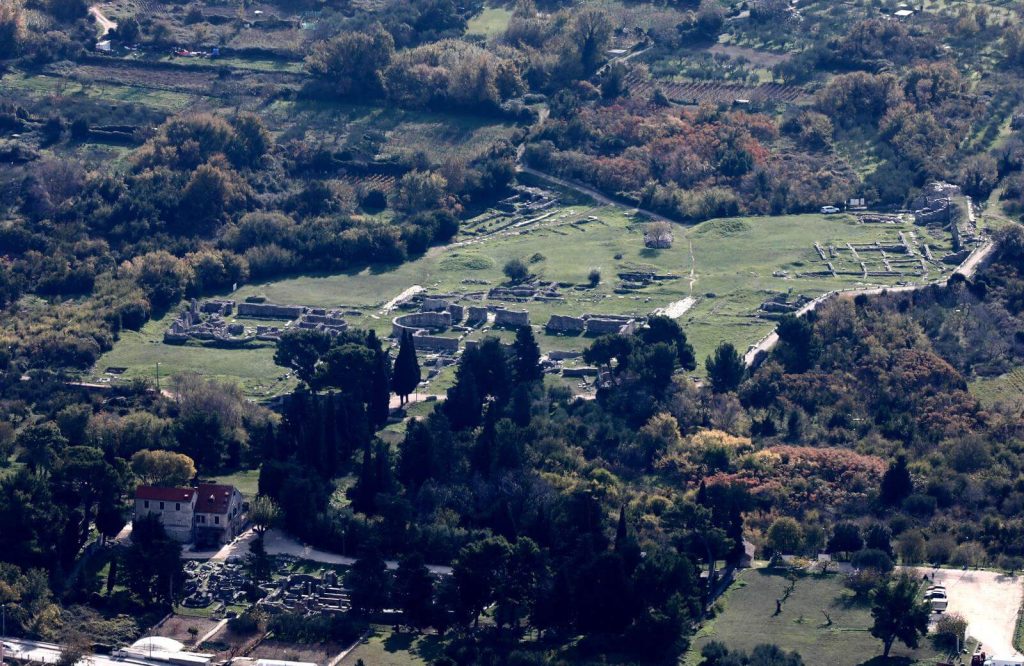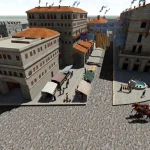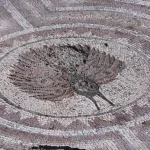No one has recently passed Porta Caesarea, the eastern and oldest city gate on the way to the amphitheater, without being surprised by the discovered northern ramparts of Salona, the former metropolis of Roman Dalmatia, reports Slobodna Dalmacija.
Under the layers of earth, vegetation, and garbage, one of the best-preserved parts of the Salonitan rampart, “70 meters long” and “120 meters” in length, has been revived.
This research project began in mid-November last year. It will continue in the next period as there is excellent potential for discoveries and new knowledge about life in ancient Salona.
“This is a continuation of the successful cooperation between the Department of Archeology of the Faculty of Philosophy in Zagreb and the Archaeological Museum in Split, which has been going on for four years now.
The research on these northern ramparts is part of the project “New Lives of Ancient Inscriptions: Epigraphic Spoli in Central Dalmatia”, which deals with re-used ancient inscriptions funded by the Croatian Science Foundation. Our goal is to explore this and find ancient inscriptions within that research because we know that they were used extensively in the construction of Salona’s defensive walls.
This has been confirmed many times so far because, for the two hundred years that Salona has been researched, there have always been inscriptions that ended up in the ramparts as a building material,” explains Dino Demicheli, associate professor at the Department of Archeology and project leader.
“With this campaign, we wanted to discover and present the best-preserved section of the ramparts that can be visually experienced in Salona. It is this move east of the amphitheater, along the northern ramparts.
We knew that there were ramparts and towers here. Still, they were so covered with stones, vegetation, earth, that this view simply could not be experienced, unlike what you can see after three weeks of research,” Demicheli explains what they have discovered.
“These towers, which are numbered from 15 to 18 in professional literature, can now be seen very nicely, and our goal is to preserve them as soon as possible, protect them from collapsing and, of course, present them,” says the expert, explaining how the construction of this ring of ramparts began in 170 AD, but how the defensive walls were constantly repaired or upgraded after that.
“Here, you can see the ramparts, towers, and these triangular protrusions that were upgraded only in late antiquity; it is the latest phase of construction, the fifth and sixth centuries AD.
All four towers are different in appearance, construction, and size. Nevertheless, these are really impressive remains, and even when you imagine that these towers went another five to six meters in height, you can imagine what the Roman defense system looked like at that time,” he adds, emphasizing that it is essential that they confirmed the project goal and found more than 30 epigraphic monuments, i.e., exteriors.
“We have established that epigraphic monuments were used for this extension of the ramparts and that they were mercilessly inserted as construction material from the surrounding area.
These are ancient tombstones, more or less dating between the first and third centuries, and were installed, we assume, during the fourth and fifth centuries.
The ramparts are currently the greatest epigraphic resource in Salona; we find so many of them here that it is fascinating. All the necropolises were outside the city, and the ramparts were being built right on the border between the “living” city and the pagan necropolis outside Salona, which were in some way deconstructed and inserted into the ramparts.
So, in a way, they have been preserved thanks to that,” Demicheli points out, saying that they found some fascinating inscriptions.
One of them is an inscription mentioning Vital. He was one of the slaves who took care of the affairs of some very well-to-do Romans.
“At the same time, the archeological research of one of the towers began. By the way, we are now in its lower layers, while the operable part of the tower and ramparts was much higher above us.
We were amazed that along with amphorae and tegulas, we found a lot of ceramics, especially tableware, and increasingly finer pieces. However, now all this needs to be cleaned, washed, determined and defined by century.
We are only in the first layer, so who knows what is down there,” says the project manager and points out that it will take time for all this to be methodologically arranged.
Deputy Head of Research Ema Višić Ljubić, senior curator of the Archaeological Museum in Split, emphasizes the importance of cooperating with the Zagreb Department of Archeology and their students. It all started in 2018 with the research of the building with the Episcopal Center and continued with the protective research of the Gradina fortress.
With all the above and current research, we discover new buildings and gain insights about Salona. Most of the knowledge that our predecessors left us in professional literature has been confirmed, and it is incredibly fascinating how many tombstones we have found.
We are delighted because this opens a new story about Salona; we learn a lot about its population and life in it. Nearby is the early Christian site of Kapljuč, which previously had the stage of a pagan cemetery, so a lot of material was built into the ramparts from that site.
Indeed, this complements our knowledge of Salona we have inherited since the beginning of our research,” says Višić Ljubić. The project included research associate Ana Demicheli and the Archaeological Museum and senior curator Jagoda Mardešić and Nino Švonja, curator of the epigraphic collection.
“This is the longest stretch of the ramparts that can now be seen from the outside, so only here can the visitor experience the defensive power of Salona with all these towers that are especially dense on the north side of the walls,” adds archaeologist Mardešić.
“Mostly there is still work to be done on conservation, on partial reconstruction, but we are very pleased that we have started this process,” Mardešić points out.
The importance of the entire campaign is confirmed by Dr. Ante Jurčević, director of the Archaeological Museum.
“The arrangement of the ancient northwestern ramparts began at the end of 2020, removing vegetation but also large debris, mostly of asbestos origin, which was dumped next to the towers in large quantities. Since the towers are next to the central communication, i.e., the road, it was convenient for people to throw garbage there.
After these works, research began, which included towers and cleaning the front walls, and the Archaeological Museum continued to clean the entire area to the amphitheater.
We cleaned about two hundred meters of low vegetation, removed most of the bulky waste from the surface of the towers and ramparts. Our goal is to present the rest of these towers that connect to the amphitheater in the same way by the end of 2022 so that this whole move from Kapljuč to the amphitheater is preserved and presented.
The northwestern ramparts are being arranged with the help of the Croatian Science Foundation, the Ministry of Culture, as well as our museum funds,” says the director and announces that they plan to arrange an early Christian cemetery in the second phase of organizing and cleaning the Salona archeological site.
“We intend to conserve and finally arrange the tomb of St. Domnius, and then the Episcopal complex from which we want to remove long-standing accumulations of earth and stone that were formed during 50 years of research. This is followed by research, conservation, and site presentation.
Our goal in cooperation with the Croatian Restoration Institute is to arrange the western necropolis, i.e., the part that is currently underwater, as well as the part of the western ramparts that are also overgrown and are located near the entrance to the INA plant in Sveti Kajo,” the director announces numerous projects for an even better presentation of these inexhaustible archeological treasures.
Everyone is incredibly proud that this cooperation with the Faculty of Philosophy in Zagreb revived the student fields that existed in the 60s and 70s when archaeologist Duje Rendić Miočević brought students who researched at Porta Caesarea.
Students of the Department of Archeology who participated in this research are Tomislav Kiš, Santa Duvnjak, Vinko Udiljak, Martin Sokolić, and Nera Janković, as well as two doctoral students on the project of the Croatian Science Foundation, Josip Parat and Krešimir Grbavac.
Everyone will continue to work in the field because their experiences in Salona are significant to them. They were supported by the City of Solin, the Tourist Board, and the Public Institution of Culture “Zvonimir”.
“This field is fantastic for them; they, like all of us, are fascinated by the result because a lot has been achieved in a brief period, and what makes us happy are the reactions of people who walk through Salona every day. No man hasn’t stopped and said, ‘Well folks, this is fantastic, we didn’t even know this was here!’
However, all this needs to be protected, that is, preserved, so we still have a lot of work to do,” concludes Demicheli.
You can see photos and videos at Slobodna Dalmacija
To read more about lifestyle in Croatia, follow TCN’s dedicated page.










